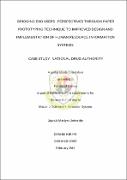Bridging end users perspectives through paper prototyping technique to improved design and implementation of human resource information systems
Abstract
System design techniques offer a promising approach towards improved development and implementation of Human Resource Management Systems (HRMS) in organisations. However, the development of appropriate and scalable HRM systems in Uganda has been difficult to achieve, due to ‘design-reality gap’, inadequate use of systems among others. The study aimed at identifying the role of paper prototyping in the design of usable Human Resource Management Systems in organisations. Paper prototyping technique was used because according to Synder, 2003, it is a quick and easy way to design and refine user interfaces while collecting continuous feedback from the users. Paper Prototyping also stimulates creative designs, which allow the developer to generate feedback on the prototypes before the application is developed. National Drug Authority was used as a case study. Combining participatory research and design science helped to grasp the inter-play between system relevance and rigor of developing the system. Further, Implementation of the HRMS was based on the Technology Acceptance Model (TAM), which is a widely used model in the design and implementation of Information systems. TAM was used to give a holistic approach to user perception of the system developed. The findings showed coherence between user requirements and the capabilities of the system developed. They also showed that the system developed was easy to use and useful in improving HR work processes. Engaging the users in the participative design sessions improved user attitude towards the system, which increased their satisfaction with the system. Furthermore, the participants were able to identify with the systems developed, which was a significant indicator of the link between paper prototyping sessions and improved design and implementation of HRMS in organisations.


